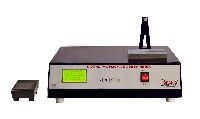
T-MAZE FOR RAT & MICE
35,000 - 68,500 Per Piece Unit
1 Unit (MOQ)
The T-maze is a commonly used behavioral apparatus in research with rodents, typically rats and mice, to study learning, memory, decision-making, and spatial navigation. Here are the primary uses and significance of the T-maze in pharmaceutical and neuroscience research: Primary Uses of the T-Maze Assessment of Learning and Memory: Spatial Learning and Memory: The T-maze is often used to assess spatial learning and memory. Rodents learn to navigate the maze to find a reward, typically food or water, based on spatial cues. The ability to remember and navigate to the correct arm of the maze indicates intact spatial memory. Working Memory: The T-maze is used to evaluate working memory by requiring the animal to remember and use information over short periods. A common procedure involves alternation tasks, where the rodent must remember which arm it previously entered and choose the opposite arm in subsequent trials. Decision-Making and Cognitive Flexibility: The T-maze can be used to study decision-making and cognitive flexibility. Researchers can set up tasks that require the animal to adapt to changing rules or conditions, testing their ability to switch strategies and learn new rules. Pharmacological Testing: Cognitive Enhancers: The T-maze is utilized to test the effects of cognitive enhancers or nootropic drugs. Improved performance, such as increased correct choices and faster learning, indicates the efficacy of these compounds in enhancing cognitive function. Cognitive Impairments: The maze is also used to model cognitive impairments caused by factors such as aging, neurodegenerative diseases, or drug treatments. Poor performance in the maze can reflect deficits in learning, memory, or decision-making. Studying Neurotransmitter Systems: Researchers use the T-maze to investigate the role of different neurotransmitter systems (e.g., cholinergic, dopaminergic, glutamatergic) in cognitive processes. By administering specific receptor agonists or antagonists, they can study how these systems affect learning and memory. Behavioral Phenotyping: The T-maze is used for behavioral phenotyping of genetically modified rodents. By comparing the performance of wild-type and genetically altered animals, researchers can identify the effects of specific genes on cognitive functions. Modeling Psychiatric and Neurological Disorders: The T-maze is employed to model and study various psychiatric and neurological disorders, such as schizophrenia, Alzheimer's disease, and attention deficit hyperactivity disorder (ADHD). Changes in maze performance can provide insights into the pathophysiology of these conditions and the potential therapeutic effects of drugs. Procedure Overview Apparatus Setup: The T-maze consists of a central starting arm and two choice arms arranged in a T-shape. One of the choice arms typically contains a reward (food or water). Training Sessions: During training, the rodent is placed in the start arm and allowed to choose between the two choice arms. The goal is for the animal to learn which arm consistently contains the reward. Testing Sessions: Spontaneous Alternation: In spontaneous alternation tasks, the rodent is expected to alternate its choice of arms in successive trials, which tests working memory. Forced Choice Tasks: In forced choice tasks, one arm is blocked, forcing the rodent to choose the open arm. In subsequent trials, both arms are open, and the animal must remember which arm was previously blocked to make a correct choice. Data Analysis: Researchers analyze the number of correct choices, latency to choose an arm, and patterns of arm entries to assess learning, memory, and decision-making abilities.

pharmacology lab instruments
Get Price Quote
Tail Flick Analgesia Meter measures pain sensitivity in mice and rats as they respond to heat application to a small area of the tails. The instrument has a shutter-controlled lamp as a heat source. The lamp is located below the animal to provide a less confining environment. Lamp starts 5 seconds prior to actual shutter opening so that the heat source provides a constant temperature to the animal's tail, avoiding temperature variations which are most common with non shuttered systems. The animal is generally restrained and its tail is placed on a sensing groove on top of the instrument. Activation of an intense light beam to the tail results in a discomfort leading to tail flick out of the beam at some time point. Instrument can be used in auto mode or manual mode. In the manual mode, the foot-switch is released. In the auto mode the photo detector detects the tail flick, causing the timer to stop. The total time elapsed between shutter opening and animal's tail flick is displayed on an easily read display located on the front panel.
Best Deals from Pharmacology Instruments